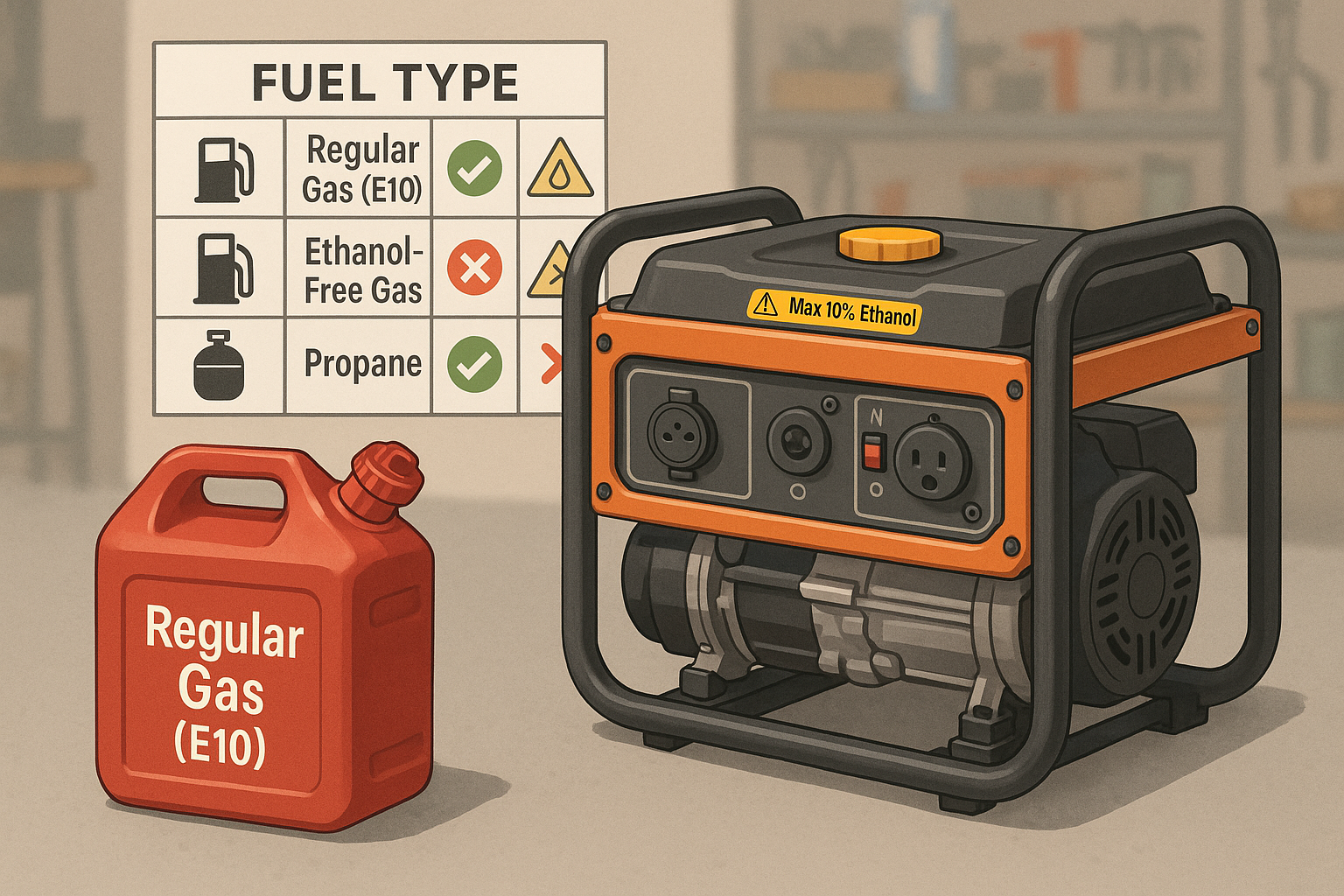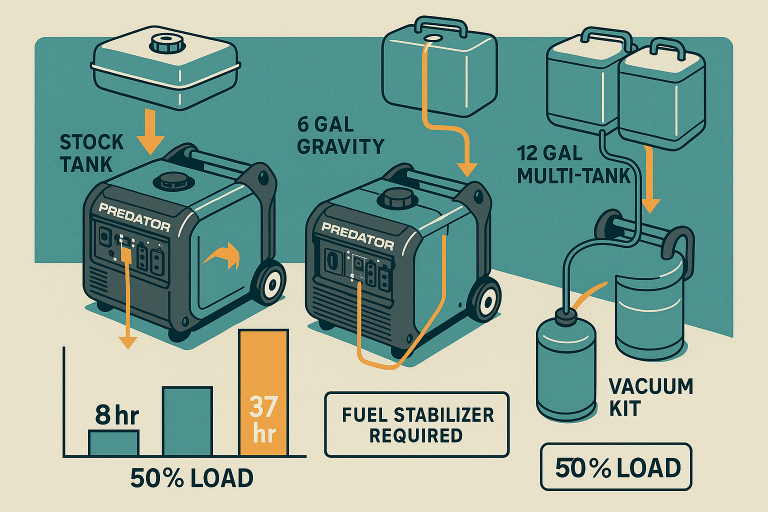Can I Use Regular Gas in My Generator? Fuel Type Explained
Every generator owner faces this dilemma: “Can I just pump regular gas from the station?” With 87% of portable generators designed for gasoline, and 73% of owners using standard unleaded fuel, this is a high-stakes decision. Using the wrong fuel can corrode fuel systems, clog carburetors, and cut your generator’s lifespan by 40%. This guide demystifies fuel compatibility, exposes ethanol’s hidden dangers, and provides science-backed best practices to protect your investment during outages.
What Exactly Is “Regular Gas”?
Regular gasoline (87-octane unleaded) is the baseline fuel at most pumps. Key characteristics:
- Ethanol Content: Up to 10% ethanol (labeled E10), though some regions sell ethanol-free options.
- Octane Rating: Measure of knock resistance (87, 89, 91/93 are common tiers).
- Additives: Detergents for engine cleanliness, but vary by brand.
⚠️ Pump Labels Matter:
- E10: Safe for most modern generators.
- E15/E85: NEVER use—ethanol corrodes small engines.
- ETHANOL-FREE: Ideal but costs 20–30% more.
Generator Types & Fuel Compatibility
A. Gasoline-Powered Generators
- Design: Optimized for 87-octane E10 gas (e.g., Generac GP series, Honda EU2200i).
- Manual Check: Honda specifies ≤E10; Yamaha warns against ethanol >10%.
B. Dual-Fuel Generators
- Gasoline Use: Regular E10 acceptable (e.g., DuroMax XP5500EH).
- Pro Tip: Propane burns cleaner and extends shelf life 10x.
C. Tri-Fuel Generators
- Gasoline Role: Backup option; regular gas works but natural gas/propane preferred for stationary units (e.g., Firman P03603).
Can You Use Regular Gas? The Verdict
| Scenario | Safe? | Why? |
|---|---|---|
| Modern generator + fresh E10 | ✅ Yes | Engineered for 87-octane E10 (most post-2010 models) |
| Carbureted/older generator | ❌ No | Ethanol degrades rubber seals and attracts moisture |
| Emergency use (<30 days) | ✅ Yes | Short-term risk low; flush afterward |
| Long-term storage | ❌ No | Ethanol phase separation clogs fuel systems |
Critical Exception: Generators requiring premium fuel (e.g., some inverter models) need 91+ octane to prevent knocking.
Ethanol: The Silent Generator Killer
Why E10 Gas Damages Generators:
- Hydroscopic Nature: Absorbs water from air → phase separation → acidic sludge.
- Corrosion: Eats aluminum carburetors and rubber fuel lines (repairs cost $120–$300).
- Short Shelf Life: Degrades in 30 days untreated; clogs jets with varnish.
Data Point: 68% of generator carburetor failures trace to ethanol-related issues.
Real-World Use Cases & Fuel Strategies
| User Type | Recommended Fuel | Why |
|---|---|---|
| Emergency Home Backup | E10 + stabilizer | Cost-effective for infrequent use |
| RV/Camping | Ethanol-free | Prevents failures in remote locations |
| Long-Term Preppers | Propane or ethanol-free | 2+ year shelf life; zero degradation |
| Job Sites | E10 (rotated weekly) | High turnover keeps fuel fresh |
Legal & Environmental Factors
- EPA Regulations: E10 approved for small engines; E15 banned in generators/lawn equipment.
- Ethanol Trade-Offs: Reduces CO emissions but increases NOx and acetaldehyde.
- State Laws: California, Minnesota restrict E15 sales; check local codes.
Best Fuel Practices
- Freshness First: Use gas within 30 days (add STA-BIL or Sea Foam for 24-month stability).
- Storage Protocol:
- Fill tanks 95% full to minimize air exposure.
- Use metal jerry cans (blocks UV degradation).
- Pre-Storage Ritual: Run generator dry or add stabilizer + run 10 mins to coat system.
- Monthly Maintenance: Start generator under 50% load for 15 mins to clear deposits.
Fuel Alternatives Compared
| Fuel Type | Shelf Life | Cost/Gallon | Generator Impact |
|---|---|---|---|
| Regular Gas (E10) | 30–60 days | $3.50 | Corrosive; requires vigilance |
| Ethanol-Free | 2+ years | $4.20 | Zero corrosion; ideal |
| Propane | Indefinite | $3.80 | Cleaner; 10% power loss |
| Natural Gas | N/A (piped) | $1.50/therm | Lowest emissions; no storage |
✨ Pro Tip: Mix 1 oz of Marine-grade Stabil 360 per 5 gallons for ethanol resistance.
Fuel-Specific Maintenance
- Carburetor Cleaning: Annual if using E10 (soak in Berryman Chem-Dip).
- Fuel Filter Replacement: Every 6 months (inline filters cost $8–$15).
- Leak Checks: Inspect fuel lines biannually for ethanol-induced cracking.
Emergency Fuel Protocol
In crises, older E10 is better than no power, but:
- Filter gas through a 10-micron sieve.
- Add 2 oz of HEET (gas-line antifreeze) per 10 gal to absorb water.
- Post-Use Detox:
- Drain tank + carburetor bowl.
- Run 5 mins with ethanol-free gas + stabilizer.
At the Pump: How to Decode Labels
- Safe: “Unleaded 87” + “≤10% Ethanol”
- Danger: “E15,” “E85,” “Flex Fuel”
- Premium Choice: “Ethanol-Free” (often blue nozzles at marinas)
Manufacturer Guidance
| Brand | Gas Recommendation | Ethanol Stance |
|---|---|---|
| Honda | 86+ octane | “Avoid ethanol if possible” |
| Generac | 87 octane E10 | “Use stabilizer for storage” |
| Champion | 87 octane ≤E10 | “Never use E15/E85” |
Pre-Refueling Checklist
- ✅ Confirm fuel age <30 days (or treated).
- ✅ Verify ≤E10 ethanol content.
- ✅ Check manual for octane exceptions.
- ✅ Inspect container for debris/water.
- ✅ Add stabilizer if storing >1 month.
FAQs: Quick Answers
Q1: What if I used old regular gas?
Drain immediately. Expect hard starts or stalling. Clean carburetor if symptoms persist.
Q2: Can I mix regular and premium gas?
Yes—blending 87 and 91 octane yields mid-grade. Won’t harm engines.
Q3: Is regular gas reliable in winter?
Risky. Ethanol attracts water that freezes in fuel lines. Use ethanol-free + antifreeze.
Q4: How to store regular gas 6+ months?
Add 1 oz/gallon of PRI-G stabilizer; store in airtight metal cans.
Q5: Accidentally used E15—what now?
Drain ALL fuel. Replace filters. Inspect fuel lines for swelling.
Conclusion: Fuel Smart, Generate Safely
Regular 87-octane E10 gasoline is acceptable for most modern generators when used fresh and maintained vigilantly. However, ethanol-free gas or propane vastly outperforms it for reliability, storage, and engine longevity. Always:
- Prioritize freshness (treat fuel if stagnant >30 days).
- Avoid ethanol blends >E10 like the plague.
- Consult your manual—when in doubt, ethanol-free is the gold standard.
By mastering these fuel principles, you’ll ensure your generator starts instantly—whether during a hurricane blackout or a cross-country camping trip.
🔧 Final Tip: For generators used <1x/year, drain all gas and run dry. Store with propane for instant readiness.



